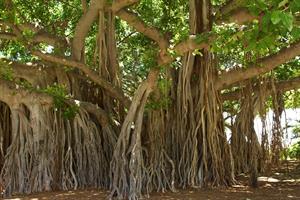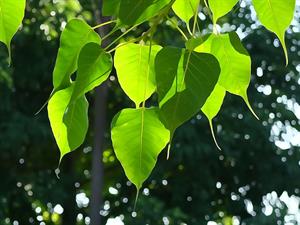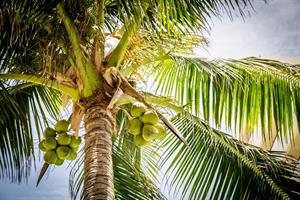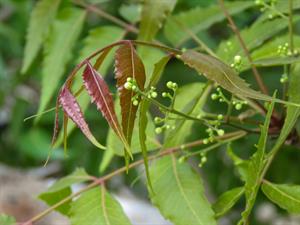PDF chapter test TRY NOW
The Banyan is the largest of trees,
The Peepul quivers in the breeze,
The Coconut grows up straight and tall,
The Neem tree's fruits are very small,
The Peepul quivers in the breeze,
The Coconut grows up straight and tall,
The Neem tree's fruits are very small,
Introduction to the poem:
The poem is adapted from a poem written by Sara Coleridge. Sara (\(1802\)-\(1852\)) was an English author and translator. She had written the poem "Trees" about oak, aspen, peach, willow trees etc. The same has been adapted for Indian trees.
Explanation of the poem:
The poet says the banyan tree is the largest of all trees. The banyan tree is a huge tree with aerial roots(roots are found hanging in the air). It has a thick trunk and glossy leaves. It provides food for birds and shelter for birds, animals and humans.

Banyan tree.
The peepul tree is also known as the sacred fig tree or the mulberry tree. It has a beautiful heart-shaped leaf; it trembles and shakes rapidly, even in a gentle wind, which looks attractive. It has a lot of medicinal values and cures many health problems.

Leaves of the peepul tree.
The coconut tree, unlike the banyan, the tree grows tall and straight. The coconuts have water inside, which has a lot of medicinal properties. Oil is extracted from coconuts which have excellent nutritive value; it is used for cooking and cosmetic purposes. Other uses include using the shells and husks for craftworks.

Coconut tree with coconuts.
The neem tree is another Indian tree that has a lot of medicinal value. The fruits and seeds are tiny but are a rich source of neem oil.

The fruits of neem tree.
Reference:
State Council of Educational Research and Training (2019). Term-1 English Standard-6. Trees - Sara Coleridge (pp. 123-124). Published by the Tamil Nadu Textbook and Educational Services Corporation.
